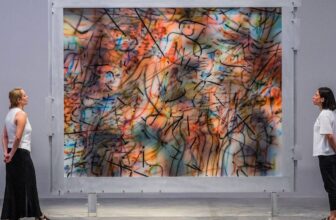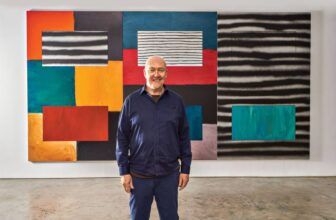What are Olafur Eliasson Famous Installation Artworks
In the shadowy halls of the Tate Modern, a blazing sun once hung inside the museum’s vast Turbine Hall. Mist drifted across the floor, silhouetting visitors as they basked under the artificial golden glow. This was not a cosmic anomaly but an art installation, “The Weather Project”, by Icelandic-Danish artist Olafur Eliasson. A master of light, perception, and spatial manipulation, Eliasson has changed the way the world sees installation art.
With an uncanny ability to merge science, natural elements, and immersive experiences, Olafur Eliasson has created some of the most iconic installation art pieces of the 21st century. His work blurs the line between art and the environment, inviting people to not just view his work but to inhabit it, to feel, reflect, and transform along with it.
Who Is Olafur Eliasson?
Born in Copenhagen in 1967 to Icelandic parents, Olafur Eliasson grew up between two worlds: the Danish cityscape and the raw, untamed beauty of Iceland. His childhood summers spent amid geysers, glaciers, and volcanic landscapes would later echo throughout his artistic practice.
Eliasson studied at the Royal Danish Academy of Fine Arts, but it wasn’t the sterile white walls of galleries that would define his trajectory. Rather, it was the expansive intersections of art, architecture, technology, and ecology. In 1995, he founded Studio Olafur Eliasson in Berlin, a laboratory of over 100 people, including architects, engineers, technicians, designers, and art historians. Together, they have built a powerful creative engine that produces installations as intellectually rigorous as they are sensorially breathtaking.
What Is Olafur Eliasson Known For?
Eliasson is best known for creating large-scale immersive installations that transform spaces using light, water, temperature, air currents, fog, mirrors, and even smells. His work is often described as experiential, visitors become part of the art through their sensory interactions.
He is celebrated for his conceptual integration of natural phenomena into artificial settings, provoking awareness about environmental issues and the limits of human perception. Eliasson’s installations do not merely depict nature; they simulate and reconstruct it within urban and architectural contexts, challenging viewers to reassess the boundaries of reality and illusion.
Olafur Eliasson Famous Installation Artworks
1. The Weather Project (2003), Tate Modern, London
Perhaps his most iconic work, The Weather Project transformed the Tate’s Turbine Hall into a surreal indoor sunscape. Using monofrequency lamps, haze machines, and a massive mirror ceiling, Eliasson recreated an ethereal sun that seemed to hover with a dreamlike aura. The immersive installation drew over two million visitors, making it one of the Tate’s most successful exhibitions.
2. Your Rainbow Panorama (2011), ARoS Aarhus Kunstmuseum, Denmark
This permanent installation crowns the ARoS Museum, a circular, glass walkway suspended above the roof, tinted in the colors of the rainbow. Walking through it, visitors are immersed in shifting hues of light that transform the surrounding cityscape, encouraging an almost meditative awareness of light, color, and motion.
3. Waterfalls (2008), New York City
Commissioned by the Public Art Fund, The New York City Waterfalls was one of Eliasson’s most ambitious public projects. Four man-made waterfalls were installed along the East River, including under the Brooklyn Bridge, each towering up to 120 feet high. The project combined industrial scaffolding with the raw power of falling water, symbolizing both nature’s majesty and humanity’s impact on the environment.
4. Ice Watch (2014–2018), Various Locations
In collaboration with geologist Minik Rosing, Ice Watch involved placing enormous chunks of ice, harvested from Greenland’s melting ice sheet, in urban centers like Paris, London, and Copenhagen. As the ice melted in real time, the installation served as a visceral, time-lapse symbol of climate change, forcing passersby to confront its urgency.
5. Room for One Colour (1997, ongoing)
This minimalist installation involves a room lit entirely by monochromatic yellow sodium light. Visitors inside perceive only shades of gray, heightening the viewer’s self-awareness and sensory dependence. It’s a deceptively simple but powerful example of how light can manipulate perception.
6. Beauty (1993)
A shimmering curtain of mist and light, Beauty is a sensory masterpiece. A fine spray of water crosses the room, lit by a spotlight at just the right angle to produce a magical, ephemeral rainbow, visible only when the viewer stands in the perfect spot.
How Does Olafur Eliasson Make His Installation Art?
The creation of an Eliasson installation is not the romantic image of a lone artist toiling in a studio. It’s a collaborative, interdisciplinary process. Studio Olafur Eliasson functions more like an architecture firm or scientific lab than a traditional artist’s atelier.
His team consists of engineers, craftsmen, lighting experts, programmers, and researchers, all of whom contribute to the technical complexity of his work. Projects often begin with questions about perception, ecology, or social interaction. From there, the team builds prototypes, models, and digital simulations before constructing full-scale installations.
Much of the studio’s work also explores sustainable practices. For example, Eliasson co-founded Little Sun, a social business that produces solar-powered lights and chargers, combining art with renewable energy to provide light to off-grid communities.
What Materials Does Olafur Eliasson Use?
Eliasson’s materials are as diverse as his ideas. They include:
Light: Monofrequency lamps, LED arrays, and natural sunlight.
Water: In mist form, waterfalls, or still pools.
Mirrors and glass: To manipulate perception and multiply perspectives.
Natural elements: Ice, moss, fog, earth, and wind.
Steel, aluminum, scaffolding: For structure and industrial contrast.
Color filters and lenses: To alter light and affect spatial awareness.
These materials serve a conceptual purpose as much as an aesthetic one. For Eliasson, the material is secondary to the experience it generates. His installations often demand viewer participation; perception itself becomes the medium.
What Art Style Is Olafur Eliasson Associated With?
Eliasson is most closely associated with:
Installation Art
Conceptual Art
Environmental Art
Light and Space Movement
Relational Aesthetics
His work draws inspiration from movements such as minimalism (in terms of spatial awareness and simplicity of form), land art (for its focus on natural phenomena), and experiential art (where audience engagement is crucial).
Unlike traditional static works, Eliasson’s pieces are time-based and experience-driven, shifting according to light, viewer movement, or environmental conditions.
Where Is Olafur Eliasson’s Installation Art Located?
Eliasson’s installations span the globe. Some of his most prominent locations include:
Tate Modern, London
ARoS Aarhus Kunstmuseum, Denmark
Louisiana Museum of Modern Art, Denmark
Museum of Modern Art (MoMA), New York
Fondation Beyeler, Switzerland
PinchukArtCentre, Kyiv, Ukraine
Palace of Versailles, France
National Gallery of Denmark, Copenhagen
Harpa Concert Hall, Reykjavík, Iceland
Munich Re Building, Germany (permanent kinetic façade)
His outdoor and public works have appeared in cities like New York, Paris, Berlin, Beijing, and Tokyo, often responding to local climates or ecological challenges.
How Many Installation Artworks Has Olafur Eliasson Created?
As of 2025, Eliasson has created over 100 major installation artworks, along with countless smaller experiments, public sculptures, and collaborative projects. His body of work spans three decades, with frequent new commissions appearing in major international biennials, museums, and public spaces.
His portfolio includes:
Permanent installations: Over 20 worldwide.
Temporary exhibitions and installations: Dozens in global institutions.
Collaborative and public art projects: More than 40 across Europe, Asia, and the Americas.
Each installation is unique, shaped by its location, audience, and materials.
How Much Does Olafur Eliasson’s Installation Art Cost?
Pricing Eliasson’s work depends on scale, materials, and whether it’s a public or private commission. Broad estimates include:
Small or medium installations: $250,000–$1 million
Large-scale public commissions: $2 million–$15 million
Private gallery pieces (light sculptures, kinetic mirrors): $100,000–$500,000
Major museum works: Priceless in cultural value, though costing millions to fabricate
For instance, The New York City Waterfalls cost an estimated $15 million, funded through a combination of public and private support. Smaller installations like Beauty are more affordable for galleries, but still require precise engineering and space.
It’s important to note that experience and social impact are at the heart of Eliasson’s philosophy, not market value. Many of his works are freely accessible to the public and designed to raise awareness, not to be commodified.
Why Olafur Eliasson Matters
Olafur Eliasson’s art doesn’t simply sit in a room, it inhabits, transforms, and awakens. Through shimmering lights, cascading water, or the quiet melt of ancient ice, he challenges viewers to see the world, and themselves, differently. His work spans art and activism, offering not just visual wonder but ethical urgency. In a time of climate crisis, mass disconnection, and sensory overload, Eliasson invites us to pause, to look, and most importantly, to feel.
Whether under the warmth of an artificial sun, inside a spiraling mirror tunnel, or beneath a man-made waterfall, we are reminded of the fundamental power of perception. In Eliasson’s world, art doesn’t just reflect reality, it reconstructs it, one breathtaking installation at a time.




